Do Macs get viruses? Do Macs want antivirus software program? The solutions to those questions aren’t so simple as they may appear. On this article, we have a look at the risks confronted by Mac customers, and the professionals and cons of utilizing Mac antivirus software program.
Traditionally, the Mac has been thought of protected and safe for a lot of causes that we are going to go into beneath, however lately the consensus has fluctuated. The variety of Mac viruses is rising annually.
In 2021, in keeping with safety skilled Patrick Wardle, eight new Mac malware households had been recognized. Then, in 2022, 13 new Mac malware households had been found. That quantity grew once more in 2023, when a complete of 21 new Mac-targetting malware households had been found. And in 2024 22 new Mac malware households had been seen.
That may not doesn’t sound so much, in comparison with the world of Home windows, however the quantity is rising and that may be a good cause to not ignore it. Certainly, with the arrival of AI the specter of malware is just going t worsen. In its 2025 State of Malware report, Malwarebytes highlights that the following iteration of AI (agentic AI) will have the ability to act autonomously to unravel advanced, multi-tiered issues, eradicating the necessity for human labor and scaling up the quantity and velocity of assaults. Then again, Agentic AI could also be a line of defence towards malware assaults as these autonomous brokers can proactively test for vulnerabilities, monitor methods, and be certain that safety patches are in place. Extra right here: Hackers are utilizing AI to assault your Mac and it’s solely going to worsen.
We record the assorted Mac malware cases in our log of all of the Mac viruses. In accordance with Malwarebytes 2025 State of Malware report, in current instances there was a rise in macOS Stealers, malware that’s designed to seek out info comparable to authentication cookies, bank card numbers, passwords, and extra. The Atomic Stealer malware (which emerged in 2023) continues to be up to date by its creators and has been utilized in assaults.
Even Apple software program boss Craig Federighi acknowledged (again in Might 2021) that Mac malware is an issue, though it’s price allowing for that on the time he was attempting to make the case for iOS’s very totally different method to safety. He stated: “We have a level of malware on the Mac that we don’t find acceptable,” Federighi revealed that 130 totally different circumstances had been documented since Might 2020, and that considered one of these had affected greater than 300,000 Macs. He even admitted that members of his household had received malware on their Macs.
When the decide requested about the truth that Mac customers should purchase and obtain software program from varied locations on the Mac, slightly than being restricted to the Mac App Retailer, Federighi stated: “Yeah, it’s certainly how we’ve done it on the Mac and it’s regularly exploited on the Mac. iOS has established a dramatically higher bar for customer protection. The Mac is not meeting that bar today.”
Federighi famous that Mac customers don’t obtain as a lot software program as iOS customers, and argued that if iOS was as open to third-party downloads there can be an actual downside for that platform. “If you took Mac security techniques and applied them to the iOS ecosystem, with all those devices, all that value,” he stated, “it would get run over to a degree dramatically worse than is already happening on the Mac.”
Do I would like antivirus for Mac?
So ought to Mac customers begin panicking? No. Mac malware does pose a danger that customers ought to pay attention to, but it surely doesn’t comply with that Mac customers should arm themselves with antivirus software program. Such merchandise have their benefits and it’s possible you’ll select to put in one for extra peace of thoughts, however we don’t view them as important for the Mac.
For one factor, there are measures put in place by Apple on the working system degree that ought to defend Mac customers from the worst malware threats. Macs include antivirus and different built-in security measures make attacking a Mac significantly difficult. They embrace Gatekeeper, which blocks software program that hasn’t been digitally authorised by Apple from operating in your Mac with out your settlement, and XProtect, which is Apple’s personal antivirus constructed into macOS and inspects each app for malware.
Apple goes to nice lengths to guard you from malware by making it nearly inconceivable to put in it. Earlier than you possibly can set up an app, your Mac will test it towards an inventory of malware, and even when there is no such thing as a cause for concern it won’t make it straightforward so that you can open an utility from a developer that hasn’t been authorised by Apple. Moreover, Apple does a fairly good job of preserving on high of vulnerabilities and exploits; in case your Mac must be protected against these, a patch will shortly be pushed out over auto-update.
These options and different protections constructed into macOS (which we’ll focus on in additional element beneath) imply it’s not a necessary requirement to put in antivirus software program in your Mac.
Nevertheless, nearly as good as these protections are, there have been events when malware has managed to infiltrate the Mac platform, and instances when Apple hasn’t responded to a risk as shortly as Mac customers may hope. In order for you the easiest safety from threats, subsequently, contemplate including a devoted Mac safety suite comparable to our high choose Intego Mac Web Safety. You’ll discover Intego in our roundup of the perfect antivirus for Mac, amongst different free and paid-for antivirus apps that may provide you with some peace of thoughts, together with McAfee and Norton.
Get Intego Mac Safety X9 right here
Learn on to seek out out extra about how Apple’s safety measures work–and why they is probably not sufficient to maintain your Mac safe.
How Apple protects Macs from viruses
Macs are typically safer than PCs, however with threats to the Mac rising because of the platform’s growing reputation, Apple has needed to construct in protections for macOS and the Mac {hardware} itself.
On this part, we’ll have a look at the built-in protections in macOS to determine whether or not they’re sufficient, or should you must also set up antivirus software program in your Mac.
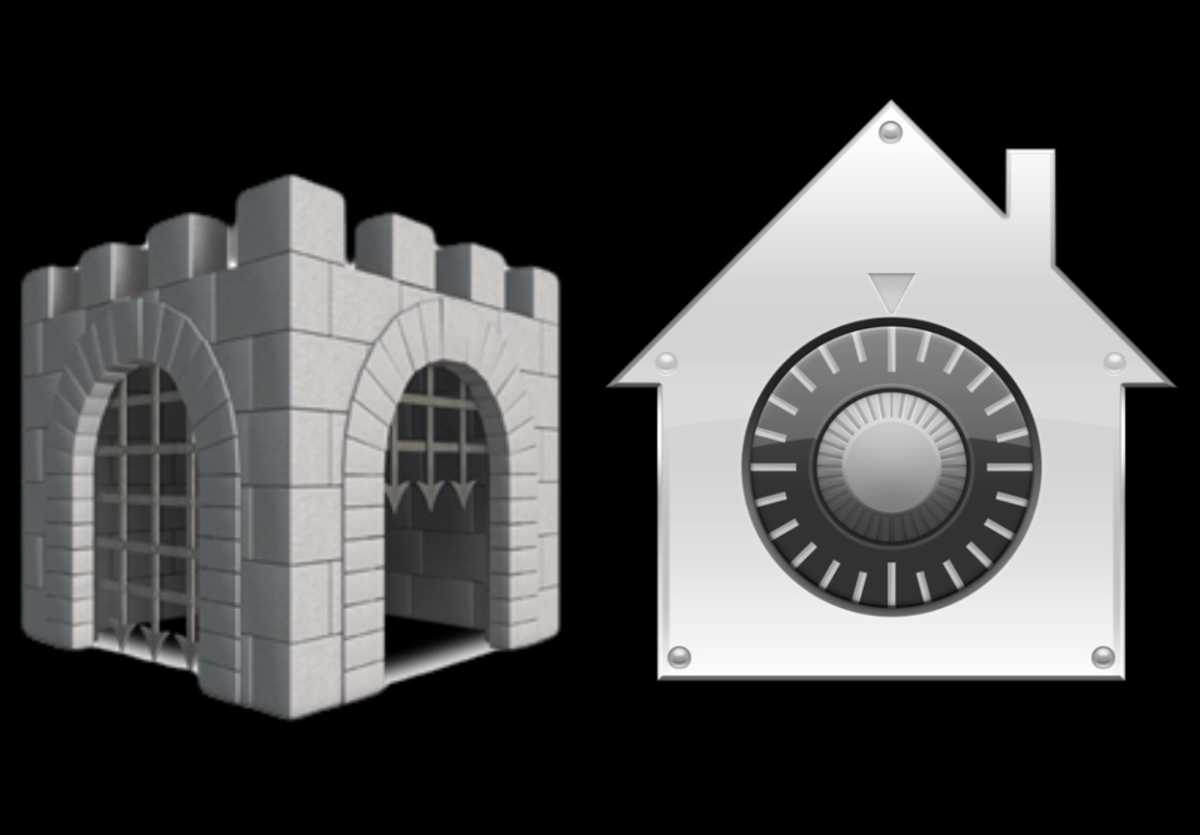
Gatekeeper and XProtect are two parts of Apple’s macOS safety.
How XProtect works
Apple has its personal antivirus software program in-built. The Mac’s malware scanning device, XProtect, works invisibly and routinely within the background and requires no person configuration. Apple has an inventory of malicious functions that it checks towards if you open downloaded functions. XProtect is recurrently up to date by Apple, and it updates within the background, so you need to at all times be protected.
The presence of XProtect is much like having antivirus software program from a third-party software program developer operating in your Mac, with the bonus of being written into the working system and subsequently not hampering efficiency. With XProtect operating, should you obtain and attempt to open information contaminated with malware, you may even see an specific warning that the information will “damage your computer,” together with a reference to the kind of malware. In that case, you need to delete the file instantly.
Learn our roundup of the Greatest Mac antivirus apps for an in-depth analysis of the choices on the market.
How Gatekeeper works
Gatekeeper in your Mac ensures that every one apps from the web have already been checked by Apple for recognized malicious code. Because of Gatekeeper, macOS blocks downloaded software program that hasn’t been digitally signed, a course of whereby Apple approves the developer and points a certificates. This certificates tells Apple who the developer is and if it’s blacklisted, and if the software program has been tampered with since leaving the developer for distribution.For those who attempt to set up unsigned software program you will note the message: “[This app] can’t be opened because it is from an unidentified developer.” One change to Gatekeeper that arrived in macOS Catalina just a few years again was that software program is checked for malware and different points each time it runs, slightly than simply the primary time you put in it.
For max safety, GateKeeper will be set to solely permit software program to be put in if it was downloaded from the Mac App Retailer. Or you possibly can set it to permit you to set up software program from the net, however from verified builders solely.
Open System Settings.
Choose Privateness & Safety.
Scroll all the way down to the Safety part.
Select from the choices beneath Enable Functions Downloaded From.
Select App Retailer or App Retailer and Recognized Builders.
The most secure choice is App Retailer solely, however should you additionally need to have the ability to set up authentic software program from the net then App Retailer and Recognized Builders is the perfect plan. There was an extra choice to disable the characteristic by selecting ‘Anywhere,’ however this selection is not obtainable.
All software program downloaded through the App Retailer is signed, however do you have to try and open an app you’ve downloaded from the net that isn’t signed, you’ll see a Gatekeeper warning just like the one beneath:

This may occasionally imply you’ve nearly put in malware. Then again, after all, it could be a authentic app. During which case (and should you’re certain) you possibly can bypass Gatekeeper’s safety and set up it.
To take action, go to the Finder and find the app there. Now maintain down Ctrl if you click on on the app, after which choose Open. This can mark it as being trusted. For extra particulars, learn how you can open an app from an unidentified developer.
Having the ability to obtain unsigned software program may sound like a profit, but it surely basically allows you to bypass the protections supplied by Gatekeeper. That’s a blended blessing, and increasingly more malicious apps are instructing customers to do precisely this when they’re put in.
Lockdown Mode
Lockdown Mode is a characteristic that arrived in macOS Sonoma in 2023 that makes it straightforward to guard your Apple gadgets and your knowledge if you’re the sufferer of a cyberattack.
Simply activate Lockdown Mode and all of your Apple gadgets will likely be protected and the hacker will discover it so much more durable to steal your knowledge.
Learn: Tips on how to activate Lockdown Mode and defend your iPhone or Mac from a cyber assault.
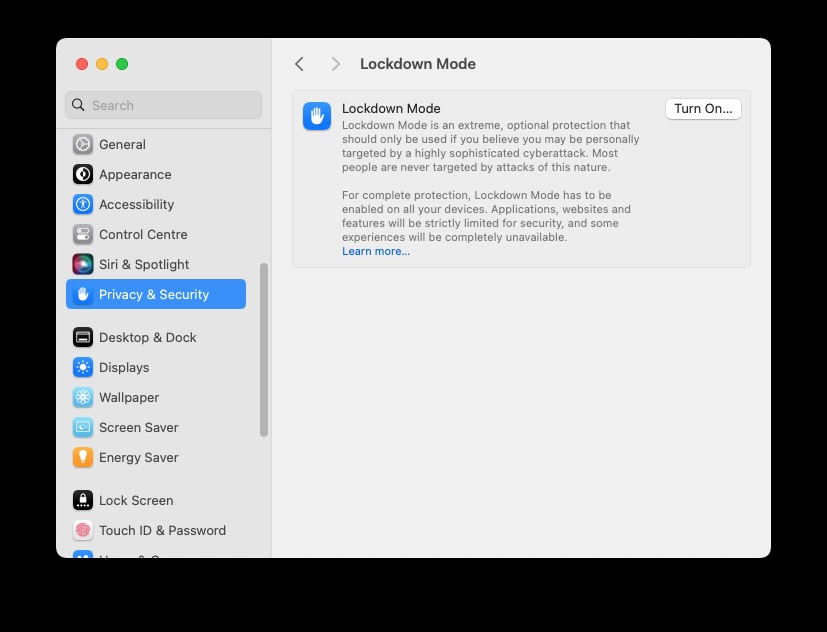
Foundry
Sandboxing and associated protections
Software program that’s authorised by Apple can also be sandboxed. App sandboxing isolates apps from the essential system elements of your Mac, your knowledge and your different apps, so that they shouldn’t have the ability to modify different apps with out permission. It doesn’t defend you from malware entering into the system, but it surely does restrict the extent of what the malware can do as soon as it’s in there. The primary downside right here is that whereas apps bought on the Mac App Retailer should be sandboxed, different Mac apps don’t.
One other subject with Sandboxing was highlighted in August 2023 when software program developer Jeff Johnson launched particulars a few flaw in App Administration that entails the Sandbox. App Administration is a safety characteristic launched in macOS Ventura that’s supposed to stop malicious software program modifications by preserving an eye fixed out for makes an attempt by software program to change different apps on the Mac. Ought to this occur, App Administration will block the modification and alert the person. The priority was that customers may grant permission for such a change with out being warned that it’s a sandboxed app, thereby bypassing a test by App Administration.
Since macOS 10.15 Catalina arrived in 2019 it has been a requirement for all Mac apps to get your permission earlier than they’ll entry your information. macOS will even ask on your permission earlier than an app can entry the digicam or microphone, or log what you sort. A possible subject right here is that customers see these alerts so incessantly it turns into second nature to approve them with out consideration.
One other change that arrived with macOS Catalina is that macOS itself is now saved on a separate disk quantity. Which means your vital system information are all fully separate and subsequently more difficult to entry. Apps can’t get to your system information the place they might trigger issues.
Background Job Supervisor
With macOS Ventura in October 2022, Apple added Background Job Supervisor, a device utilized by macOS to observe for “persistent” software program and notify the person of any suspicious exercise.
In August 2023, Mac safety researcher Patrick Wardle criticized the device suggesting that it may simply be bypassed in order that malicious software program can run with out the person understanding it.
Wardle found methods to disable the notifications that Background Job Supervisor sends to the person when a persistence occasion is acknowledged. One technique requires root entry, which signifies that the risk agent wants full management of the Mac to disable the alert, however Wardle discovered two different strategies that may be deployed remotely. So an attacker may disable the notifications and permit the malware to run unnoticed.
Wardle wrote: “[Background Task Manager is] a good thing for Apple to have added, but the implementation was done so poorly that any malware that’s somewhat sophisticated can trivially bypass the monitoring”.
Safety updates
Apple recurrently points safety updates for the Mac. Whereas these can serve to display that the Mac isn’t infallible, with Apple all too incessantly having safety flaws identified to it, they’re typically issued promptly.
These safety updates have typically been issued as half of a bigger macOS replace: for instance, macOS Monterey 12.2.1 closed a safety vulnerability in WebKit that will have made it attainable to execute malicious code. As a result of these safety fixes had been issued as a part of a macOS replace, which regularly requires the pc to reboot through the set up course of, Mac customers could also be much less prone to set up the replace promptly, despite the fact that these updates will be set to put in routinely.
Because the launch of Ventura, nonetheless, Apple has began separating out the safety updates from wider macOS updates and rolling them out routinely. This fashion the replace can occur within the background, and not using a restart.
Typically, Apple can reply shortly because it makes the software program and the {hardware}. However the issue is extra prevalent when Apple has much less management over the difficulty, as with Intel’s Downfall processor vulnerability that affected Macs with Intel chips constructed between 2016 to 2020. Intel patched the difficulty, however launched that its Downfall patch may sluggish some CPUs. When you have a Mac that makes use of Apple Silicon (an M1 or M2-based processor), you don’t have anything to fret about. It’s cause to think about upgrading if in case you have an Intel-powered Mac.
Because of this you will need to instal updates from Apple – however not simply Apple. It’s vital to put in updates for all of your apps recurrently. Builders repair safety points through updates. The Mac App Retailer normally does job of preserving apps up to date routinely, however we suggest checking no less than as soon as a month for any updates that may not have been put in. In the case of apps you’ve downloaded from exterior the App Retailer, it’s essential to test for updates within the app’s menu bar choice.
Password safety and Passkeys
Apple’s iCloud Keychain is a password supervisor that was launched in 2011 with Mac OS X Mavericks (and iOS 7). It was an evolution of Apple’s Keychain software program for managing passwords and login info that arrived with MacOS 8.6 in 1999, however introduced this functionality to all Apple gadgets, permitting for passwords to be synced and used throughout gadgets. So password administration is nothing new on the Mac. Nevertheless, Apple is shifting it up a notch in macOS Sequoia.
The primary change that arrived with Sequoia is how straightforward it will likely be to seek out your passwords. At present customers should look in Settings: go to System Settings (System Preferences) > Passwords. There it’s attainable to unlock with the principle password to see each different password ever used. (View this similar info on an iPhone in Settings > Passwords.) With the arrival of Sequoia (and iOS 18) customers will see a devoted app for password administration, slightly than it being hidden in Settings (which can in all probability assist some individuals uncover it).
The advantage of iCloud Keychain and the Password app is that it is just vital to recollect one password to unlock all of the passwords you want. No have to memorize a whole lot of totally different passwords – or extra probably use one easy-to-remember (and crack) password for every part. Apple will even show you how to create a robust password and can warn you in case your password is simple to hack, if in case you have reused a password, and if it has appeared in a leak. If it ever detects a safety concern, Password Monitoring will provide you with a warning.
Over time Apple’s password protections have improved. For instance, in Monterey a brand new authenticator was added, so you possibly can arrange verification codes as a substitute of utilizing an authentication app. So as to add a setup key it’s essential to click on on a password after which select Enter Setup Key, which you need to have the ability to get hold of from the supplier. As soon as enter the 2FA verification codes ought to routinely fill.
In macOS Ventura Apple launched Passkeys. Apple explains: “Passkeys use iCloud Keychain public key credentials, eliminating the need for passwords. Instead, they rely on biometric identification such as Touch ID and Face ID in iOS, or a specific confirmation in macOS for generating and authenticating accounts.” Passkeys are safer, in keeping with Apple. Basically your system will maintain one a part of a cryptographic key pair and the opposite half will likely be saved by the web site or service you’re logging into. Your system will authenticate you biometrically (with Contact ID or Face ID) and log you in. For extra info, learn Tips on how to use Passkeys.
One other new characteristic added in Sonoma is a simplification of the method for sharing passwords with family and friends. Customers can create a gaggle and share a set of passwords to that group. It’s end-to-end encrypted.
Recording alerts
In macOS Monterey Apple added a Recording indicator within the menu bar so that you’ll know if an app is recording you. A bit like the sunshine that signifies the mic is in use in your iPhone.
Pasteboard alerts
Equally, as of macOS Ventura, any app that desires entry to your pasteboard has to request permission.
Safari protections
Anti-phishing expertise in Safari will detect fraudulent web sites. It would disable the web page and show an alert should you go to a suspect web site.
You’ll additionally discover that plug-ins comparable to Silverlight, QuickTime, and Oracle Java received’t run in the event that they aren’t up to date to the most recent model, one other approach of making certain your Mac is protected. And naturally now that Adobe has discontinued Flash individuals ought to hopefully not fall for malware hidden in Flash Participant.
Safari will even flag up weak passwords and make robust password strategies if you open an account on a web site. This robust password will likely be saved in your iCloud Keychain so that you received’t have to recollect it. It’s so much safer than utilizing the identical password you at all times use. For extra on this topic, examine How Apple plans to retire passwords.
Prior to now, one subject with Apple’s instructed passwords has been that generally they don’t match the web site’s necessities. For instance, a web site could require one upper-case letter, one particular character, one quantity and so forth. As of the launch of Ventura, macOS permits customers to edit instructed passwords so that they meet these necessities.
The Safari Non-public Shopping characteristic improved with macOS Sonoma. You may set a brand new Non-public Shopping Lock to seem on the display to cease onlookers from viewing your display if you aren’t current.
Non-public Shopping additionally stops web-based trackers from recording knowledge about you through monitoring codes by eradicating these codes. Monitoring info is even eliminated should you hyperlinks through Messages or Mail.
Photograph privateness
A number of years in the past there was a whole lot of unhealthy publicity for Apple when celebrities reported that their iCloud pictures had been stolen. (For extra on this, learn Tips on how to cease photograph hacks on iPhone.) There have been a lot of safety enhancements in iCloud since this occurred, and Apple has given customers different methods to guard their photograph privateness: for instance, the power to cover pictures and albums. In Ventura, Apple expanded this in order that hidden albums, and the Not too long ago Deleted album, are locked by default, and solely authenticated by Contact ID or Face ID.
Mail protections
You may flip this on in System Preferences > click on on Apple ID > and choose Non-public Relay (presently in Beta).
In Ventura Disguise My Electronic mail was prolonged to third-party apps.
iCloud+ protections
For those who’re an iCloud subscriber, you’ll be enthusiastic about a characteristic that arrived in Monterey (a part of the improve from iCloud to iCloud+) known as Non-public Relay. It’s a bit like a VPN in that it encrypts your community visitors and routes your DNS lookup requests by two servers, considered one of which isn’t managed by Apple. Nevertheless, it’s not a VPN, as a result of it solely works in Safari and clearly it lacks the opposite traditional options of a VPN. (In order for you a VPN, by the way in which, try our roundup of the perfect VPNs for Mac. You could even have the ability to avoid wasting cash should you check out our roundup of VPN offers, or attempt considered one of these free VPNs.)
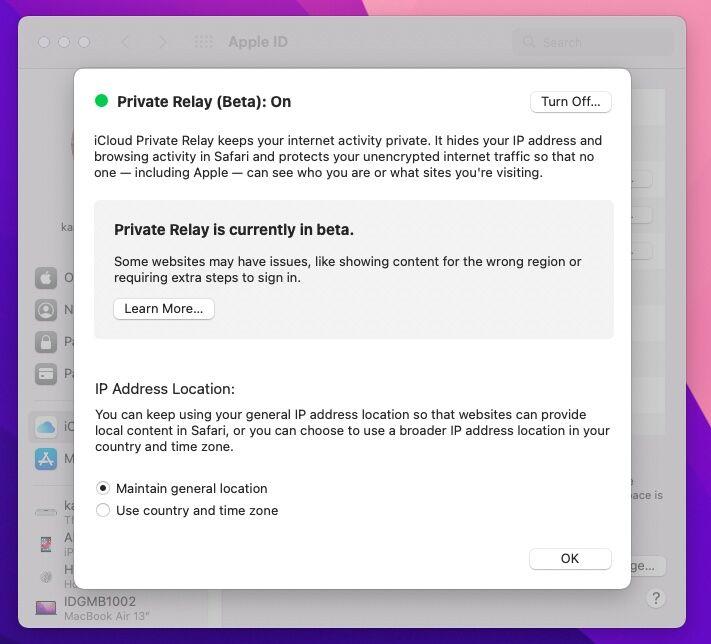
Security Verify
A brand new characteristic in macOS Ventura is Security Verify, a characteristic that can permit anybody who is anxious that they’re at risk from an individual recognized to them to revoke any entry they’ve granted to that individual. So, for instance, that individual received’t have the ability to entry their location, their pictures, or anything that would assist them to be traced.
File encryption with FileVault
FileVault–Apple’s identify for full-disk encryption–makes certain your knowledge is protected and safe by encrypting it. Intel Macs that featured the T2 Safety Chip and all M-series Apple silicon Macs have encryption in-built on the backside degree of macOS. The startup inner quantity is at all times encrypted, and you’ll’t flip it off. FileVault additionally encrypts exterior volumes.
With FileVault in your Mac’s drive is totally encrypted and encryption keys (protected by your account password) are required to unlock it. In case your Mac is encrypted with FileVault, an attacker will likely be locked out, macOS received’t even unlock your drive for entry at startup and not using a legitimate account password or an related Restoration Key (simply bear in mind that if somebody hacked your Apple ID they might doubtlessly acquire entry to the Restoration Key and unlock your Mac’s drive).
The primary downside is that with out that Restoration Key you might be additionally locked out and received’t have the ability to entry your knowledge, so do take care of it. See Tips on how to discover your FileVault restoration key in macOS.
Learn our suggestions for preserving your Mac safe, of which utilizing FileVault is one.
Warnings about adware
The warning will provide recommendation about how affected customers can defend themselves towards assault. There’s extra info on Apple’s website.
Discover My
Not each risk to your knowledge comes from malware. Typically a felony may pay money for your Mac, through which case Apple’s Discover My service will come into its personal.
The Discover My app can relay the situation of your misplaced or stolen Mac again to you. For those who’re involved that it won’t be recoverable, you possibly can wipe the contents of the Mac in order that your knowledge can’t be accessed. For extra on this, learn Tips on how to discover a misplaced or stolen iPhone.
As well as, each Mac with an M1-series, M2-series, or T2 chip has an Activation Lock characteristic which suggests they are often erased remotely and solely you possibly can reactivate the Mac.

Siri, ID and Apple Intelligence
There are new AI options coming to macOS Sequoia and iOS 18. There could also be issues about how it will have an effect on privateness and safety as, whereas generally the processing will likely be executed on the system, in some conditions duties that want extra processing energy will likely be despatched to Apple’s servers. Throughout WWDC 2024 Apple defined that it will all be executed securely and that the info won’t ever be accessible to anybody, together with Apple. Apple’s Craig Federighi stated: “Private Cloud Compute uses your data only to fulfill your request, and never stores it, making sure it’s never accessible to anyone, including Apple. And we’ve designed the system so that independent experts can verify these protections.”
When Apple’s safety measures aren’t sufficient…
The safety measures detailed above are nice, however sadly, there have been circumstances once they haven’t been sufficient.
Gatekeeper, for instance, has sometimes been bypassed as a result of malware has received an authorised developer signature. For instance, OSX/CrescentCore was signed by a certificates assigned by Apple to a developer. It took Apple just a few days to retract that certificates.
Within the case of OSX/Linker, in the meantime, a zero-day vulnerability in Gatekeeper was exploited. Apple usually reacts shortly to such threats, though there have been circumstances the place the corporate has ignored an recognized vulnerability; on one event an adolescent reported a flaw within the group FaceTime characteristic that meant somebody may pay attention in to a name, and Apple did not act.
Intel-based Macs launched between 2018 and 2020 with the T2 safety chip had a safety flaw that was by no means mounted. Researchers discovered a vulnerability within the safety chip that would permit somebody with bodily entry to the pc to doubtlessly bypass security measures. Silicon Macs don’t endure the T2 vulnerability, however they’re not flawless. The “Augury” and “GoFetch” flaws in M-series chips are {hardware} points that can’t be patched with out severe efficiency hits. No one has actively exploited these vulnerabilities, and so long as no one will get their arms in your Mac, you have to be protected – but it surely does emphasis the significance of taking care of your Mac, for instance, not leaving it on a desk in a espresso store whilst you go to the lavatory.
When Apple is made conscious of a risk the corporate normally points a safety replace to the most recent model of macOS and to the 2 variations prior. This fashion Apple will defend customers from vulnerabilities and flaws that may very well be exploited by hackers.
Usually our recommendation can be to put in security-related updates instantly. Nevertheless, from time to time, these can themselves trigger difficulties. A Sierra and Excessive Sierra safety replace in July 2019, for instance, needed to be pulled after individuals experiences issues after putting in it.
How Apple responds to safety threats
Apple has its personal safety analysis group, but it surely will depend on customers and unbiased researchers to assist by reporting any flaws they discover in Apple merchandise.
To this finish, Apple has an incentive program that rewards such discoveries with funds of as much as $200,000, relying on the seriousness of the flaw. But it surely was the final main tech firm to arrange such a scheme. (Microsoft arrange its personal bug-reporting incentive program in 2013, and was itself criticized on the time for leaving it so late.)
On August 4, 2016, Apple safety boss Ivan Krstic introduced the Apple Safety Bounty Program. “We’ve had great help from researchers in improving iOS security all along,” Krstic stated. “[But] we’ve heard pretty consistently… that it’s getting increasingly difficult to find some of those most critical types of security vulnerabilities. So the Apple Security Bounty Program is going to reward researchers who actually share critical vulnerabilities with Apple.”
The highest reward of $200,000 is given to those that uncover vulnerabilities in Apple’s safe boot firmware elements; for much less essential flaws the bounties drop by a collection of smaller figures to a backside tier of $25,000. Wired has the main points.

We think about most Mac customers will likely be happy to listen to that Apple has an incentive program to encourage extra widespread reporting of its vulnerabilities. Incentivizing safety researchers to let Apple find out about a flaw as a substitute of passing it on to hackers (which can nonetheless, sadly, be extra profitable) makes Apple merchandise safer for everybody.
One such flaw was the Excessive Sierra root bug, found on November 28, 2017. This flaw in macOS 10.13 may permit entry to settings on a Mac with out the necessity for a password. Apple instantly issued an announcement confirming that it was engaged on a repair and that an replace ought to be issued inside days.
Tips on how to hold your Mac protected from malware
Listed here are just a few of the issues you need to do:
1) Maintain macOS updated
To cut back the impression of those dangers, you need to hold common backups and set up safety updates as quickly as attainable.
Apple addresses Mac flaws and vulnerabilities by issuing updates to the working system. It’s subsequently vital to maintain your Mac updated. Checking recurrently for OS updates is a key a part of a sound safety technique.
You will discover out in regards to the newest model of macOS right here: macOS Ventura newest model info.
Tips on how to routinely set up macOS updates
Open System Settings.
Click on on Basic.
Click on on Software program Replace.
Click on on the (i) beside Computerized Updates.
Guarantee that the choices are chosen.
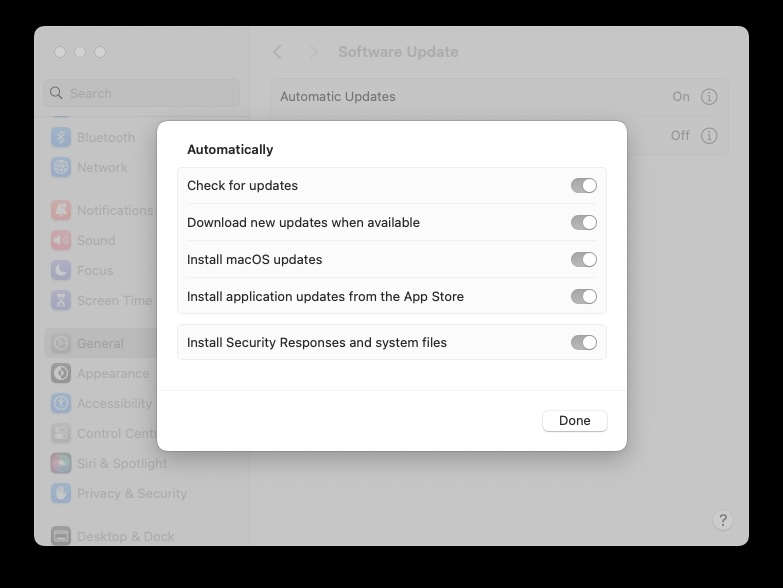
Foundry
On older variations of macOS you wanted to go to System Preferences > Software program Replace and you can have the ability to click on on Superior and choose exactly which actions you need to occur routinely from Verify for updates, Obtain new updates when obtainable, Set up macOS updates, and Set up app updates from the App Retailer.
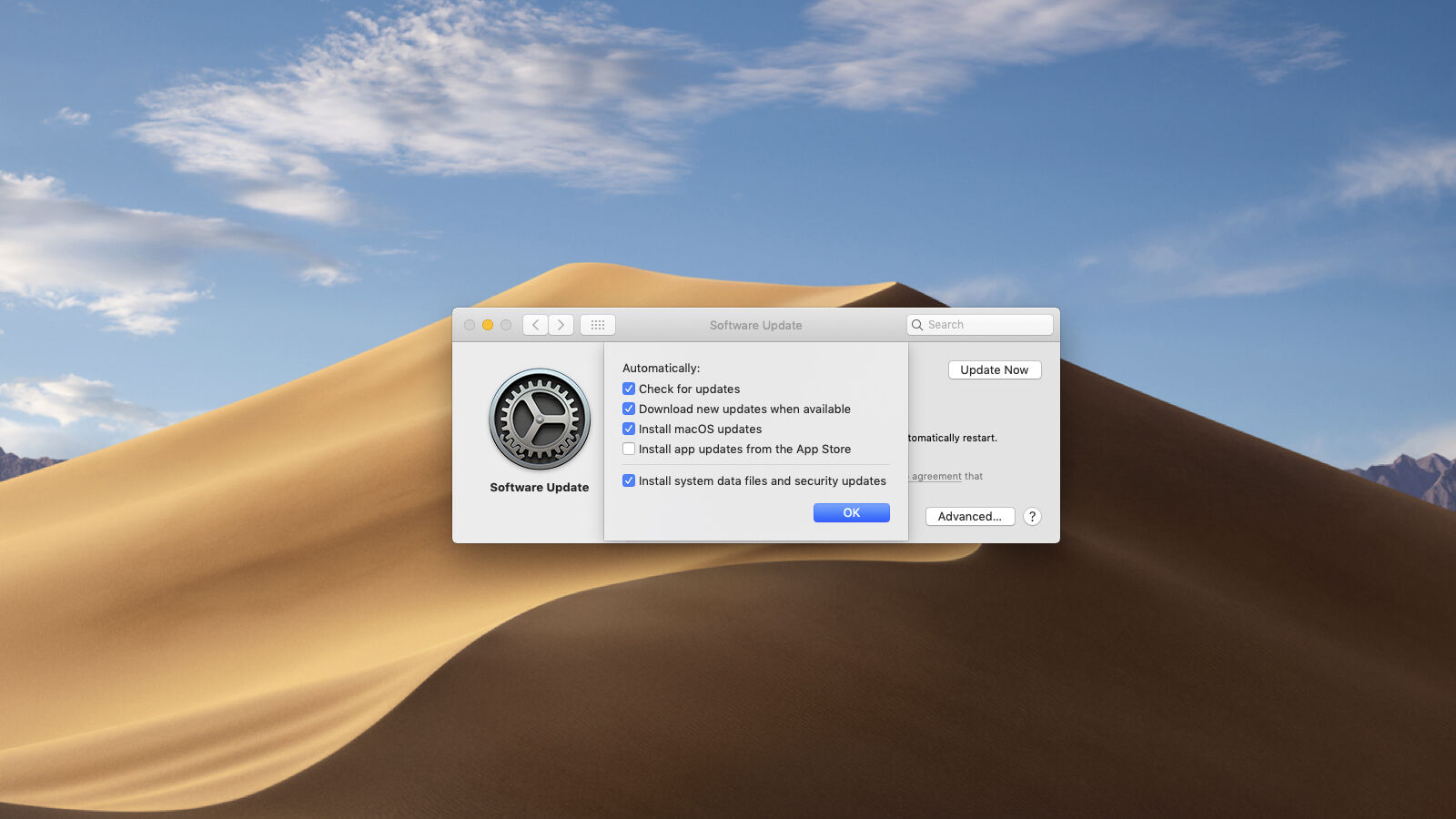
Tips on how to manually set up macOS software program updates
For those who’d slightly not let your Mac routinely replace, you need to periodically test to see if there’s an replace to your model.
Go to System Settings > Basic > Software program Replace and your Mac will test to see if there’s an replace to put in.
In macOS Mojave and older the Software program Replace pane was present in System Preferences and in macOS Excessive Sierra and earlier updates had been through the Mac App Retailer.
For our in-depth information to updating Mac working methods, see Tips on how to replace macOS.
2) Watch out about the place you obtain from
Downloading software program from locations like GitHub and different obtain websites may very well be a danger. It’s safer to obtain from the Mac App Retailer as Apple has vetted software program made obtainable there. For those who desire to not use the Mac App Retailer, then purchase software program straight from the developer’ and their’s web site.
3) Don’t connect with public Wi-Fi networks
Watch out for connecting to a public Wi-Fi community as there could also be somebody spying who may acquire entry to your passwords and different personal info, or you can have your session hijacked. Snoopers can arrange their very own Wi-Fi hotspot, pretending to be your resort or espresso store, then after you have linked they’ll seize any knowledge you ship over it.
4) Don’t set up Flash
Adobe discontinued Flash on 31 December 2020 with good cause. Intego, Malwarebytes and different safety firms have really helpful that you simply shouldn’t set up Flash Participant, as a result of faux Flash Participant updates have typically been used to trick individuals into putting in malware. You may be trying to obtain a preferred film or TV collection without spending a dime, for instance, and see a search end result that results in a request to replace Flash Participant in an effort to view the content material. That is unlikely to be authentic.
There’s merely no want to put in Flash Participant now that HTML5 has made Flash out of date. Our recommendation is easy: Don’t use Flash!
5) Maintain Java updated in your Mac
For those who should use Java (which can also be problematic) then be certain it’s updated. Vulnerabilities in Java have highlighted the truth that there are cross-platform threats that even Mac customers want to pay attention to. Apple blocks Java by default, leaving it as much as the person to resolve whether or not to put in these instruments. For those who do have to replace them, be very cautious the place you obtain updates from!
6) Keep away from falling foul of phishing emails
7) Don’t fall for Fb and different social community scams
Fb scams are normally designed to reap knowledge. If it looks as if it may be too good to be true, it in all probability is, and also you’d be smart to not share it on Fb. At greatest you’ll look foolish and people scammers will begin to goal you with extra scams; at worst they might reach accessing your private knowledge and that of your pals. Don’t click on on a hyperlink simply because a good friend shared it, and undoubtedly don’t give out your private knowledge on Fb.
Why it’s essential to defend Home windows customers
Macs are fairly protected from malware, however one cause to run an antivirus is to guard your Home windows-using mates and colleagues. An unprotected (and carelessly used) Mac may turn out to be a type of Typhoid Mary of Home windows viruses; in different phrases, you can be harboring viruses that received’t have an effect on you, however may very well be issues for Home windows customers.
Tips on how to inform if a Mac has a virus
Look out for the next indicators that your Mac has been contaminated with malware:
Aggressive internet web page banners and browser pop-ups recommending software program.
Internet web page textual content turning into hyperlinks.
Applications showing that you simply haven’t licensed.
Mac crashes.
Mac runs scorching.
Mac hurries up for no cause.
For those who suppose one thing suspicious is occurring, open Exercise Monitor and click on on the CPU tab. Verify what software program is operating, particularly if one thing is hogging a whole lot of your assets.
We focus on how you can determine and take care of Mac viruses in a separate article: Tips on how to take away a virus from a Mac. We additionally suggest studying Tips on how to defend your Mac towards assault for extra recommendation on avoiding digital infections.